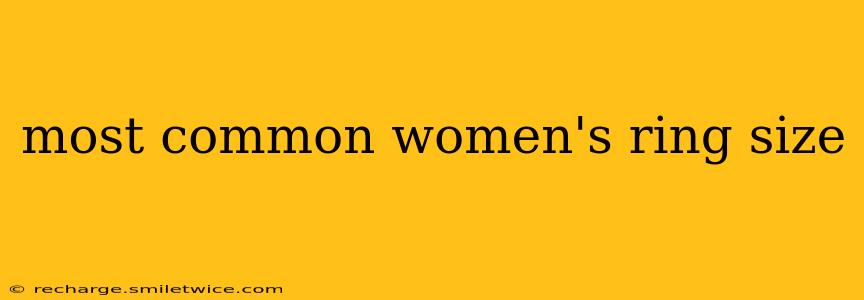Finding the perfect ring is a momentous occasion, whether it's an engagement ring, a wedding band, or a special gift. But before you even start browsing dazzling designs, understanding ring sizing is crucial. This guide delves into the most common women's ring size and explores related questions to help you navigate this important step.
What is the most common women's ring size?
The most common women's ring size in the United States and many other countries is a size 6. However, it's important to remember this is an average. Ring size varies significantly depending on factors like age, ethnicity, and even hand dominance. While a size 6 is a good starting point for general estimations, relying solely on this average could lead to disappointment. Accurate sizing is paramount for a comfortable and well-fitting ring.
How do I find out my ring size?
There are several reliable methods for determining your ring size:
- Professional Measurement: The most accurate way is to visit a jeweler. They have ring sizers and can provide a precise measurement. This is especially recommended for expensive or significant purchases.
- At-Home Ring Sizer: Many online retailers and craft stores sell inexpensive ring sizers. These tools provide a visual guide to help you determine your size using your existing rings. Remember to check multiple rings for consistency.
- Ring Size Chart: Online ring size charts can be helpful, but they rely on your measuring the inner diameter of a ring you already own, which can be less accurate than professional methods. Always cross-reference measurements.
- DIY Methods: There are DIY methods using string or paper, but these are generally less reliable and prone to error.
Does ring size change over time?
Yes, ring size can fluctuate slightly due to several factors:
- Weight Changes: Significant weight gain or loss can affect finger size, requiring a resizing.
- Temperature: Finger size can change slightly with temperature fluctuations; it’s usually a bit smaller in colder temperatures and larger in warmer ones. This minor change isn't typically enough to necessitate a resize unless it causes discomfort.
- Pregnancy and Hormones: Pregnancy can cause temporary swelling, affecting ring size.
- Age: As we age, our fingers can sometimes subtly change size.
What if I don't know my ring size?
If you're unsure of your ring size and planning to buy a ring as a surprise, there are a few sneaky strategies:
- Borrow a ring: Discreetly borrow a ring that fits well from the person you're buying for and get it measured professionally.
- Measure an existing ring: If you already have a ring that fits well, you can attempt to measure it using a ring size chart or at-home sizer, keeping the limitations of these methods in mind.
- Buy a ring with a sizing adjustment option: Some jewelers allow for easy resizing after purchase, providing flexibility if you are slightly off with the initial size estimation.
Remember, getting the size right is crucial for comfort and to ensure your precious piece fits perfectly.
What are the sizes in a ring size chart?
Ring size charts generally use numerical measurements, with size 6 being a commonly used average. The sizes usually progress in increments of 0.25 or 0.5, depending on the manufacturer and region. International standards may vary slightly, so it's best to use a chart relevant to your country or region.
Is it better to get a ring slightly bigger or smaller?
It's always better to err on the side of slightly larger rather than smaller. A slightly loose ring is more comfortable and less likely to cause discomfort or damage than a ring that's too tight. A tight ring can restrict blood flow and potentially cause damage to your finger over time.
By following these guidelines and exploring the different methods of determining your ring size, you can confidently purchase or receive a perfectly fitting ring, ensuring a truly memorable experience. Remember that precision is key when dealing with jewelry; professional sizing is always recommended.
